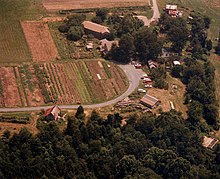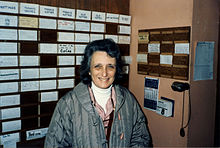Twin Oaks Community
The Twin Oaks Community is an ecovillage organized, egalitarian community with about 100 residents in Louisa County, Virginia ( USA ). Founded in 1967, the community is now one of the oldest and largest secular communities in North America. It is based on the basic values of cooperation , egalitarianism , non-violence , sustainability and common economy .
founding
Twin Oaks was founded in 1967 by eight Communards on a former tobacco farm, among them Kathleen "Kat" Kinkade , who subsequently published two books on the commune. The founders were inspired by BF Skinner's novel Walden Two , in which the psychologist and proponent of behaviorism had described a fictional utopia. Skinner's vision, however, quickly lost its relevance to members of the commune; instead of the principles of behaviorism, they soon turned to the principles of egalitarianism.
A high fluctuation of members and low incomes presented the municipality with major challenges in its first few years. However, according to Kinkade, other problems that would be stereotypically associated with communities (such as parasitism and poor organization) could be avoided by organizing work in a flexible but structured manner.
The initial structure of the municipality and its point system for work performance are basically still intact, but have been revised over time. Originally, as in Skinner's novel, Communards received different points per hour worked, depending on the task at hand. In this way, even uninteresting activities should become attractive. However, when the municipality had reached a size of around 40 members, the system was modified: It turned out that none of the activities was universally viewed as attractive or unattractive, so that the different evaluation within the point system could no longer be meaningfully understood . Today there is therefore a uniform assessment according to which every activity within the municipality is rewarded identically.
everyday life
A prerequisite for membership in the Twin Oaks Community is a three-week stay as a visitor, during which interested parties can gain an insight into the community. Newly accepted members then typically have to wait between three and nine months on a waiting list for their entry into the municipality: the municipality's capacity has been continuously exhausted since 2011. In this case, new members can only move into the municipality if another member leaves. In the past, Twin Oaks had expanded its capacities, for example with new buildings, if there was a waiting list for a longer period of time.
Unlike many other cohousing communities, there are no costs to enter Twin Oaks. In addition, no rent is due, and no other running costs are charged. Daily necessities, i.e. living space, clothing, food and medical care, are provided to the members. In return, they work around 42 hours a week for the community. Some of the work generates income for the community, the rest is housework such as cooking, maintenance, cleaning, child care and gardening. Most Communards deal with a wide range of tasks rather than restricting themselves to just one area. Members can also choose to work outside of Twin Oaks. Most of the income from this activity goes to the community, while the rest can be paid into a "vacation account". Overtime is also accumulated on this vacation account.
The members of the community often meet for common leisure activities such as dancing, meditation and board games, or they discuss literature or perform musicals. Television is only allowed to a limited extent: only recorded programs may be viewed, live programs are prohibited. However, there is access to the Internet and public computers.
The members belong to different religions and worldviews. Among them are Christians , atheists , pagans , Buddhists and others. They celebrate pagan wedding ceremonies ( handfasting ) , the equinoxes , Thanksgiving, and June 16, the anniversary of the commune's formation.
The communal accommodations are spread across the entire farm. They are equipped with private bedrooms and shared facilities.
Membership turnover is not as high as it was in the early years of the commune, and many former members now reside in nearby Charlottesville and Louisa to maintain contact with the commune.
Twin Oaks Company
The municipality has several joint ventures including Twin Oaks Tofu, Twin Oaks Hammocks, and Twin Oaks Book Indexing. Members also produce seeds for the Southern Exposure Seed Exchange with the Twin Oaks Seed Farm. From these sources, Twin Oaks generates approximately $ 600,000 a year, which is used to purchase items that it cannot produce itself and to give members as monthly pocket money. These often attribute the longevity of their community to this participation in the capitalist economic system.
Twin Oaks and other communities
Twin Oaks has three sister communities: the Acorn Community , about 7 miles from Twin Oaks, the Living Energy Farm , also in Louisa County, and the East Wind Community in Missouri .
Twin Oaks also hosts the Communities Conference and Women's Gathering annually in August - meetings of communities supported by the Fellowship for Intentional Community .
Twin Oaks in the media
The story of Twin Oaks is detailed in two books by Kathleen "Kat" Kinkade, one of the community's co-founders. The first book, A Walden Two Experiment , describes the commune's first five years, the second, Is it Utopia Yet? , the next 20. Another book from the 1980s, Living the Dream by Ingrid Komar (the mother of a Communard), also deals with the history of Twin Oaks. In addition, many newspaper and magazine articles as well as several dissertations and master's theses dealt with the municipality. A list of these publications can be found on the municipality's website.
Twin Oaks and Ecology
Twin Oaks aims to be a pioneer in sustainability. Thanks to the extensive self-sufficiency and communal use of goods, each member uses fewer resources than the average American, including 70% less gasoline, 80% less electricity and 76% less gas. In addition to the communal accommodation, there is also a shared fleet of 17 vehicles and a shared closet. Only the personal items that members keep in their bedrooms are not shared.
criticism
The municipality itself also recognizes that the goal of the perfect society in Twin Oaks has not yet been realized; they even distribute a brochure to visitors called Not Utopia Yet . For example, there is little privacy in Twin Oaks. Members who have lived in the municipality for several years also occasionally feel “trapped”, which is also attributed to the fact that members have little opportunity to save their own capital.
The founding of Twin Oaks was inspired by BF Skinner's utopia Walden Two . As a result, in the early years of the commune, members experimented with ideas of behaviorism to alter personal behaviors; but it was never intended to make behaviorism a guiding principle of the commune. Today behaviorist ideas can still be found in Twin Oaks in attempts to make work more attractive through influences such as coffee breaks or live music. Following the principle of non-violence, there is no form of punishment in the commune.
One point of criticism raised by both visitors and the communards themselves is the lack of cleanliness in the commune. The egalitarian orientation of Twin Oaks and the fact that the members choose their own activities means that there is no lower class that does unattractive tasks such as cleaning. The free choice of work does not apply to visitors, but the community rules prohibit that visitors are assigned tasks unless a member of the community is also involved in the task.
Another criticism of Twin Oaks is the reluctance to deal with interpersonal conflicts. While many other egalitarian municipalities prioritize interpersonal communication so high that they link membership in the municipality to the fact that conflicts are also dealt with, in Twin Oaks collaboration in conflict resolution (possibly also moderated by the process team ) is voluntary. Twin Oaks has no formal consequences for members who refuse to moderate the conflict in this way.
Originally, the founders had planned a membership of 1,000 for Twin Oaks. Today, the commune is often criticized for not allowing itself to grow. The number of residents has stagnated at around 100 since 1996 (including children).
Individual evidence
- ↑ a b c d e Twin Oaks . America's Mojo. November 9, 2009.
- ↑ a b c d e Virginia Commune Still Draws Members After 40 Years . Voice of America. August 29, 2009. Retrieved December 30, 2010.
- ↑ a b c Rural Community a Model 'Eco-village' . CNN. April 22, 2010. Retrieved January 13, 2011.
- ↑ a b c d e f g h The Other American Dream . In: Washington Post Sunday Magazine Page W12 . November 15, 1998.
- ↑ a b c Louisa commune flourishes for 43 years . Richmond NBC July 12th, 2010. Archived from the original on November 18th, 2011. Info: The archive link was automatically inserted and has not yet been checked. Please check the original and archive link according to the instructions and then remove this notice. Retrieved September 23, 2014.
- ↑ David Knox, Caroline Schacht: Choices in Relationships: An Introduction to Marriage and the Family . Cengage Learning, 2009, (accessed January 23, 2011).
- ↑ a b Kathleen Kinkade: A Walden Two Experiment; The First Five Years of Twin Oaks Community. William Morrow & Co, New York, Morrow 1973, ISBN 0-688-05020-4
- ↑ a b c Kathleen Kinkaid: Is It Utopia Yet ?: An Insider's View of Twin Oaks Community in Its Twenty-Sixth Year. Twin Oaks Publishing, 2nd edition, 1994. ISBN 0-9640445-0-1
- ↑ Kathleen Kinkaid: Is It Utopia Yet ?: An Insider's View of Twin Oaks Community in Its Twenty-Sixth Year. Twin Oaks Publishing, 2nd Edition, 1994, p. 9. ISBN 0-9640445-0-1
- ↑ Ashley Spalding: Positioned Within 'The Outside World' The Cultural Construction Of Gender In An Egalitarian Intentional Community . In: Dep't of Anthropology, University of South Carolina . (hosted at twinoaks.org). 2000. Retrieved January 13, 2011.
- ↑ a b c Twin Oaks: Living in Harmony . NBC 29 WVIR-TV. August 31, 2010.
- ^ A b Daniel Pinchbeck: Paradise Not Quite Lost. In: New York Times Magazine , August 3, 1997. pp. 26-29
- ↑ Twin Oaks Tofu
- ↑ Twin Oaks Hammocks
- ^ Twin Oaks Book Indexing
- ↑ Twin Oaks Seed Farm
- ^ Twin Oaks Communities Conference . Retrieved January 13, 2011.
- ^ Twin Oaks Women's Gathering
- ↑ http://www.twinoakscommunity.org/twinoaks-media
- ↑ Twin Oaks: Living a Sustainable Lifestyle . NBC 29 WVIR-TV. September 1, 2010.
- ^ A Human-Sized Answer to a Global Problem .
Web links
Coordinates: 37 ° 55 '59 " N , 77 ° 59' 38.9" W.

